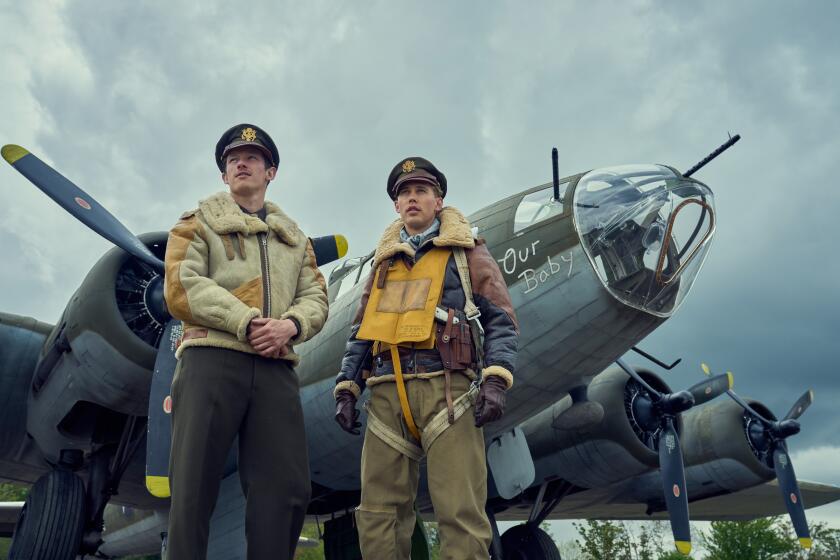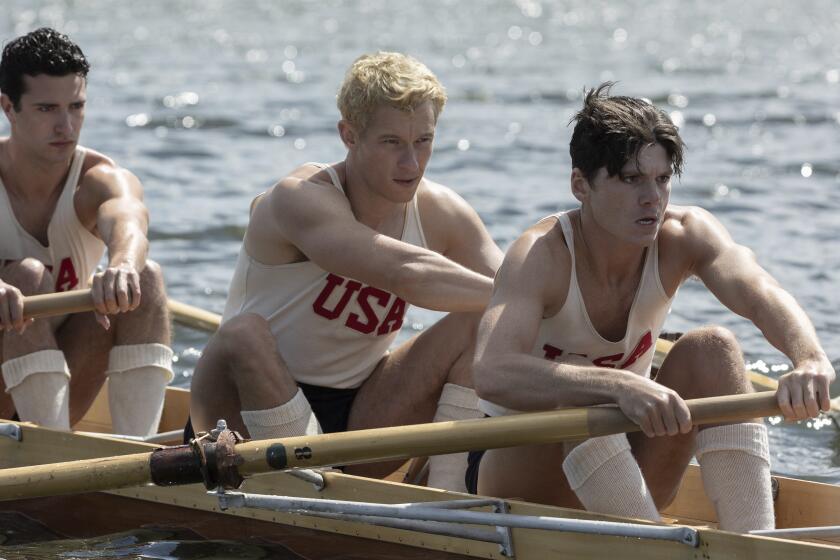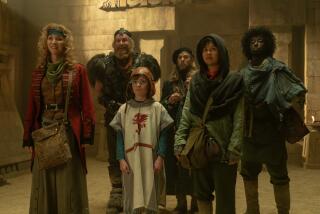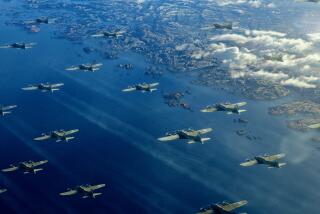
With a staggering loss rate of 77%, “The Bloody 100th” Bomb Group required 25 missions from its crewmen before they could return home from the horrors of World War II. That meant every time they got in a plane, they knew that in the next few hours they’d probably die a violent death.
“It’s an insane statistic,” says Callum Turner about the number of men sacrificed. He plays Maj. John “Bucky” Egan in Apple TV+’s “Masters of the Air,” an epic nine-part limited series about the 100th. “The journey they had to go through for the greater good, putting them in the most vulnerable atmosphere ever known to mankind,” he says, noting that the skin on the B-17 bomber was about as thick as a Coke can.
Executive produced by Steven Spielberg, Tom Hanks and Gary Goetzman, the $250-million series is based on the book by historian Donald L. Miller. Along with “Band of Brothers” and “The Pacific,” it forms a glossy trilogy of U.S. military might during World War II. Anchoring a cast of hundreds are Turner and Austin Butler as Gale “Buck” Cleven, both characters based on real-life fliers.
The latest World War II drama from Steven Spielberg, Tom Hanks and Gary Goetzman on Apple TV+ focuses on the European air war and serves as a companion to “Band of Brothers” and “The Pacific.”
“They were high-flying Hollywood types, the best pilots,” Turner says of their characters. “They joined up before Pearl Harbor. If a plane went down, Egan would write personal notes to the family because he wanted it to come from someone [the downed flier] knew rather than someone from the Army. For me, the whole journey is about finding the truth and embodying someone who is going through a living hell. It’s so important not to just show them as two-dimensional heroes. They’re actually men living through something horrific. Finding that truth was about honoring their story.”
Turner’s Egan brings a buzzy energy to the group, the actor says. “He turns up with this cocky attitude and this determination to fight the good fight.” It complements a more easygoing, internalized performance by Butler. “It’s well documented they were yin and yang, so it happened naturally. The deeper rooted he was, the more I could fly.”
Acting since his early 20s, Turner broke through playing Theseus in 2022’s “Fantastic Beasts: The Secrets of Dumbledore,” followed by last winter’s “The Boys in the Boat,” directed by George Clooney. When he and his partner, singer Dua Lipa, aren’t being hounded by tabloids, he’s in preproduction on “Eternity” with Miles Teller and Elizabeth Olsen. Not bad for a working-class lad from Chelsea.

“It gave me unbelievable drive,” he says of the underprivileged circumstances in which he was raised by a single mom, a onetime aspiring actor who worked as a nightclub promoter in the 1980s London scene. “I really didn’t have anything else. I couldn’t not succeed. There was a lot of determination, not having any money and working four jobs when I’m 21. I don’t know if I had had financial stability behind me, I would have had that drive. That really was about survival.”
Pretty soon he was making bank modeling for Reebok and Burberry. Then came such TV shows as the British miniseries “Glue” and a bit part on Showtime’s “The Borgias.” To play a swaggering Yank like Bucky Egan for “Masters” required countless hours with a dialect coach and maintaining his accent through most of the shoot. Research included documentaries shot by Hollywood heavyweights such as George Stevens and John Ford during real-life combat situations.

He didn’t get a chance to talk to many fliers from the war, except at the premiere, where they had five original members of the 100th, all of them centenarians. “We talked to hundreds of veterans,” says executive producer Goetzman. “We talked to families. We do this on all of them, ‘Band of Brothers,’ ‘Pacific.’ We have a long tradition of that. We get our best stories from them. It teaches you so much. The worse [the] experiences the men were in, the more they were reticent to talk about it.”
Some of the 100th went on to fight in Korea, perhaps inspiration for another limited series. “There are still many, many fabulous stories of World War II,” Goetzman says. “As far as us, I don’t know if we’ll ever tackle the multiple-hour limited series again. We might do a movie instead of these series that take three years to do, and they’re expensive. The studios probably aren’t interested in that length of time of this type of show, either. They don’t want to spend more money. They want it cheaper, faster.”
The leaders at USRowing have been working with producers of the new movie ‘The Boys in the Boat’ to sponsor dozens of screenings across the country.
Isolated on location in Northern England, production was shut down during COVID-19 and some cast members had to be quarantined. In all, the series took 10 months to shoot, and although it’s a fondly remembered experience, Turner is glad it’s over. The worst of it was COVID, and the best was the climactic scene at the prison camp, when the allies begin bombing and the inmates see their Nazi guards on the run. That’s when Bucky climbs atop a building and replaces the Nazi flag with the Stars and Stripes.
“As an actor, that sequence is really wonderful. We shot it right at the end, and there was a sort of a parallel in what I was going through myself, because we were coming to the end of this thing and we’d made it.” He pauses, collecting himself. “There aren’t many people left who lived it. We want to remind people what happened. We don’t want to make those mistakes ever again.”
More to Read
From the Oscars to the Emmys.
Get the Envelope newsletter for exclusive awards season coverage, behind-the-scenes stories from the Envelope podcast and columnist Glenn Whipp’s must-read analysis.
You may occasionally receive promotional content from the Los Angeles Times.











